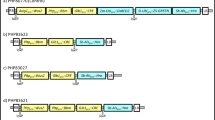Abstract
Particle bombardment and Agrobacterium-mediated transformation are two popular methods currently used for producing transgenic maize. Agrobacterium-mediated transformation is expected to produce transformants carrying fewer copies of the transgene and a more predictable pattern of integration. These putative advantages, however, tradeoff with transformation efficiency in maize when a standard binary vector transformation system is used. Using Southern, northern, real-time PCR, and real-time RT-PCR techniques, we compared transgene copy numbers and RNA expression levels in R1 and R2 generations of transgenic maize events generated using the above two gene delivery methods. Our results demonstrated that the Agrobacterium-derived maize transformants have lower transgene copies, and higher and more stable gene expression than their bombardment-derived counterparts. In addition, we showed that more than 70% of transgenic events produced from Agrobacterium-mediated transformation contained various lengths of the bacterial plasmid backbone DNA sequence, indicating that the Agrobacterium-mediated transformation was not as precise as previously perceived, using the current binary vector system.
Similar content being viewed by others
References
Bio-Rad Laboratories. The iCycler iQ™ Detection System for Multiplex Real-Time PCR Assays. Bio-Rad Bulletin 2620.
Carrington J.C. and Freed D.D. 1990. Cap-independent enhancement of translation by a plant potyvirus 5' nontranslated region. J. of Virology 64: 1590–1597.
Christensen A.H., Quail P.H. 1996. Ubiquitin promoter-based vectors for high-level expression of selectable and/or screenable marker genes in monocotyledonous plants. Transgenic Research 5: 213–218.
Cluster P.D., O'Dell M., MetzIaff M., Flavell R.B. 1996. Details of T-DNA structural organization from a transgenic Petunia population exhibiting co-suppression. Plant Mol. Biol. 32: 1197–1203.
Dai S., Zheng P., Marmey P., Zhang S., Tian W.Z., Chen S.Y., Beachy R.N., Fau C. 2001. Comparative analysis of transgenic rice plants obtained by Agrobacterium-mediated transformation and particle bombardment. Mol. Breeding 7: 25–33.
Depicker A., Stachel S., Dhaese P., Zambryski P., Goodman H.M. 1982. Nopaline synthase: transcript mapping and DNA sequence. J. Mol. Appl. Genet. 1: 561–573.
Duncan D.R., Spence M. 2003. An efficient system for rapid generation of low copy transgenic plants using the maize inbred H99, Poster #959. presented in Plant Biology Conference, Honolulu, Hawaii, USA, July 25–30, 2003.
Fagard M., Vaucheret H. 2000. (Trans)gene siliencing in plants: How many mechanisms? Annu. Rev. Plant Physiol. Plant Mol. Biol. 51: 167–194.
Frame B., Zhang H., Cocciolone S., Sidorenko L., Dietrich C., Pegg S., Zhen S., Schnable P., Wang K. 2000. Production of transgenic maize from bombarded Type II callus: effect of gold particle size and callus morphology on transformation efficiency. In Vitro Cell. Dev. Biol.-Plant 36: 21–29.
Frame B.R., Shou H.X., Chikwamba R.K., Zhang Z.Y., Xiang C.B., Fonger T.M., Pegg S.E., Li B.C., Nettleton D.S., Pei D.Q., Wang K. 2002. Agrobacterium tumefaciens-mediated transformation of maize embryos using a standard binary vector system. Plant Physiol. 129: 13–22.
Gelvin S. 2000. Agrobacterium and plant genes involved in T-DNA transfer and integration. Annu. Rev. Plant Physiol. Plant Mol. Biol. 51: 223–256.
Hajdukiewicz P., Svab Z. and Maliga P. 1994. The small, versatile pPZP family of Agrobacterium binary vectors for plant transformation. Plant Molecular Biology 25: 989–994.
Ishida Y., Saito H., Ohta S., Hiei Y., Komari T., Kumashiro T. 1996. High efficiency transformation of maize (Zea Mays L.) mediated by Agrobacterium tumefaciens. Nature Biotech 14: 745–750.
Kumpatla S.P., Chandrasekharan M.B., Iyer L.M., Li G., Hall T.C. 1998. Genome intruder scanning and modulation systems and transgene silencing. Trends Plant Sci. 3: 97–104.
Kononov M.E., Bassuner B., Gelvin S.B. 1997. Integration of T-DNA binary vector ‘backbone’ sequences into the tobacco genome: evidence for multiple complex patterns of integration. Plant J. 11: 945–957.
Kovtun Y., Chiu W.L., Tena G., Sheen J. 2000. Functional analysis of oxidative stress-activated mitogen-activated protein kinase cascade in plants. Proc. Natl. Acad. Sci. USA 97: 2940–2945.
Martineau B., Voelker T.A., Sanders R.A. 1994. On defining T-DNA. Plant Cell. 6: 1032–1033.
Mason H.S., DeWald D., Mullet J.E. 1993. Identification of a methyl jasmonate-responsive domain in the soybean vspB promoter. Plant Cell. 5: 241–251.
Matzke A.J.M., Neuhuber F., Park Y.D., Ambros P.F., Matzke M.A. 1994. Homology-dependent gene silencing in transgenic plants: epistatic loci contain multiple copies of methylated transgenes. Mol. Gen. Genet. 244: 219–229.
Matzke M.A., Matzke A.J.M., Eggleston W.B. 1996. Paramutation and transgene silencing: a common response to invasive DNA? Trends Plant Sci. 1: 382–388.
Muskens M.W.M., Vissers A.P.A., Mol J.N.M., Kooter J.M. 2000. Role of inverted DNA repeats in transcriptional and post-transcriptional gene silencing. Plant Mol. Biol. 43: 243–260.
Osterman J.C., Dennis E.S. 1989. Molecular analysis of the ADH1-Cm allele of maize. Plant Mol. Biol. 13: 203–212.
Vaucheret H., Béclin C., Elmayan T., Feuerbach F., Godon C., Morel J.B., Mourrain P., Palauqui J.C., Vernhettes S. 1998. Trans-gene-induced gene silencing in plants. Plant J. 16: 651–659.
Vaucheret H., Fagard M. 2001. Transcriptional gene silencing in plants: targets, inducers and regulators. Trends Genet. 17: 29–35.
Wang K., Genetello C., Montagu M.V., Zambryski P.C. 1987. Sequence context of the T-DNA border repeat element determines its relative activity during T-DNA transfer to plant cells. Mol. Gen. Genet. 210: 338–346.
Wenck A., Czako M., Kanevski I., Marton L. 1997. Frequent collinear long transfer of DNA inclusive of the whole binary vector during Agrobacteriummediated transformation. Plant Mol. Biol. 34: 913–922.
Zhao Z.Y., Gu W., Cai T., Tagliani L.A., Hondred D.A., Bond D., Krell S., Rudert M.L., Bruce W.B., Pierce D.A. 1998. Molecular analysis of T0 plants transformed by Agrobacterium and comparison of Agrobacterium-mediated transformation with bombardment transformation in maize. Maize Genet. Coop. News-letter 72: 34–37.
Author information
Authors and Affiliations
Corresponding author
Rights and permissions
About this article
Cite this article
Shou, H., Frame, B.R., Whitham, S.A. et al. Assessment of transgenic maize events produced by particle bombardment or Agrobacterium-mediated transformation. Molecular Breeding 13, 201–208 (2004). https://doi.org/10.1023/B:MOLB.0000018767.64586.53
Issue Date:
DOI: https://doi.org/10.1023/B:MOLB.0000018767.64586.53




